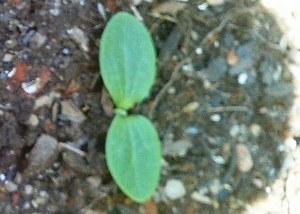This article tells you how to start garden plants from seed. There are a lot of good reasons to grow your own plants from seed. First, you save money. Second, you can start the exact variety you prefer. Third you can grow healthier more disease free plants. Finally, it’s just plain fun, and even educational.
General Information
Home supply stores sell various kits for starting garden plants from seed. These kits are overpriced, unnecessary, and often difficult to get good results with.
So called “peat pots” (compressed plantable peat material) have the same problems. No professional growers use them. They are designed to protect plants from so-called “transplant shock”, but that is pure mythology. They are difficult to handle and it is hard to maintain decent climate and moisture control over them. Furthermore, transplant shock is not much of a problem for most common vegetable and flower plants.
Ordinary “flats” are the best way to start your baby plants; or, if you want to save money, you can drill holes in the bottom of a plastic dish pan or cut off plastic jugs.
Pre-sprouting
If you are starting plants on a small scale, pre-sprouting is a great way to improve your yields and start healthier plants. See the article How to Pre-sprout Garden Seeds for detailed information.
Preparing the Container
To prepare the container for planting, first fill it with starter soil. You can purchase starter soil at a garden supply center or you can make your own (see Make Your Own Seed Starter Soil). Thoroughly wet the soil in the container and allow it to drain and dry out to the point where it is moist but not sopping wet. Due to settling you may need to add more soil. If the seeds are tiny, you can plan on planting them on the surface and dropping a layer of soil over them, rather than trying to poke tiny holes for planting.
Use a stick to poke holes to the depth recommended by your seed supplier, drop the seeds in the holes, and cover them. As previously stated, you can put tiny seeds on top of the soil and give them a dusting of soil to cover them. Once the seeds are planted, water them thoroughly using the shower setting on a hose nozzle or a sprayer. Don’t flood the soil, or the seeds will be displaced.
Maintenance
When weather permits, keep the container outside, and water every few days or when the soil appears to be drying out. If the daytime weather is reasonably warm (above 45 degrees) and sunny you really cannot over-water your plants. They are happiest when wet, warm, and taking in sun, with a gentle breeze.
Transplanting
When the plants are a reasonable size and there is no danger of frost, transplant them to your garden. Use a trowel to cut little divots of soil around the roots of your baby plants and gently transfer them to their new location. Water your baby plants thoroughly after planting and as necessary until they have reconnected to the soil in their new location.


